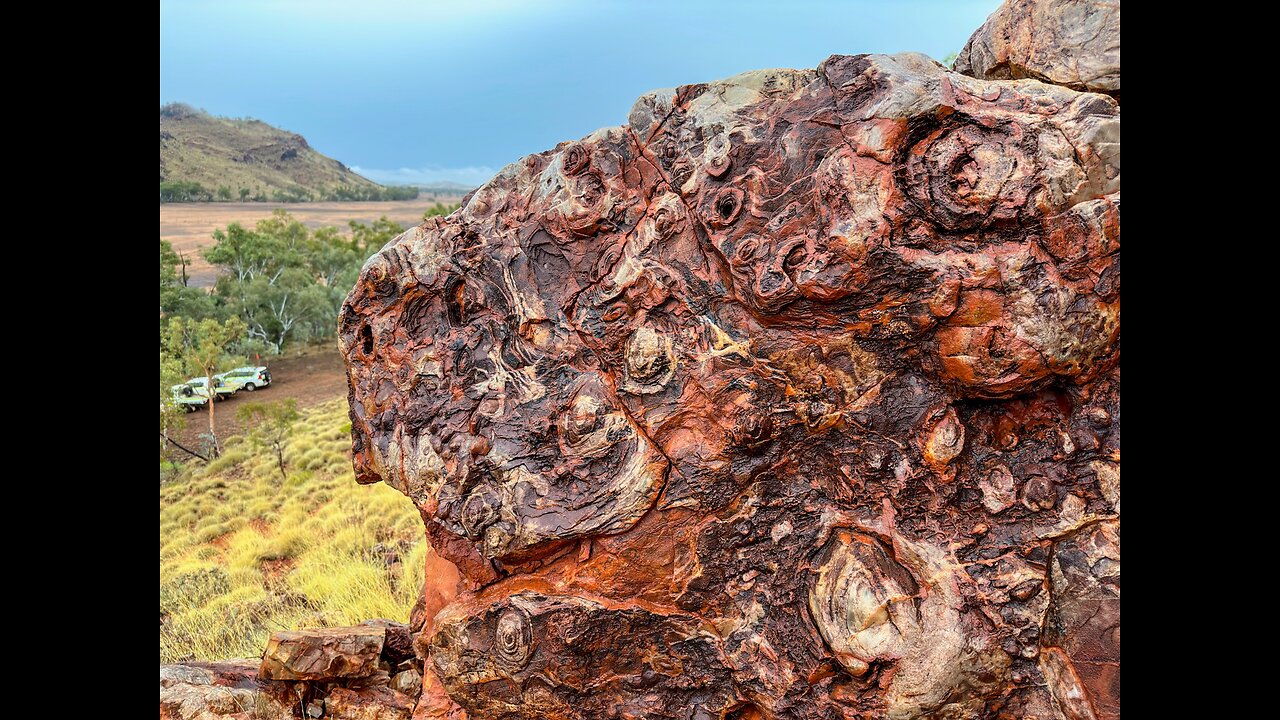Premium Only Content

NASA is working with its international partners to study the ancient Earth as it relates to Mars.
Members of NASA's Mars Exploration Program, the European Space Agency, the Australian Space Agency, and the Australian Commonwealth Scientific and Industrial Research Organization are in Western Australia's Pilbara region to investigate "stromatolites," the oldest confirmed fossilized lifeforms on Earth. They discuss the importance of geological context when choosing sampling sites and ensuring the integrity of a sample's biological origin while considering plans for future missions to bring Mars samples to Earth. Credit: NASA/Mike Toillion.
NASA is working with its international partners to study the ancient Earth as it relates to Mars.
In June 2023, NASA's Mars Exploration Program leaders joined their counterparts from the Australian Space Agency, ESA (European Space Agency), and the Australian Commonwealth Scientific and Industrial Research Organization (CSIRO) on a field expedition to visit some of the oldest convincing evidence of life on Earth.
"This science expedition was a great opportunity for NASA to work with our international partners to study the ancient Earth as it relates to Mars, which may have had a similar past," said Eric Ianson, director of NASA's Mars Exploration Program at NASA Headquarters in Washington. “The more we learn about our planet's evolution, the more we can apply that knowledge to our characterization of the Red Planet.”
The Pilbara in the Western Australian Outback is one of the few places in the world to hold an ancient geological record of our ancient planet. As the international community continues working together to study Mars and prepare for samples to bring to Earth, these teams explored what our own backyard can teach us about the search for life elsewhere.
"What we're looking at here in Western Australia are known as stromatolites," said Mitch Schulte, program scientist for the Mars Perseverance Rover at NASA Headquarters. "They're fossils caused by mats of microorganisms living around 3.5 billion years ago that had their presence captured and preserved in the rock record for all this time."
Due to the geological processes that continually reshape and recycle the Earth’s surface, it is extremely difficult for stromatolites or other fossils to be preserved on Earth for long periods of time, so only a fraction of past life remains in the geological record. In the Pilbara region, the rock record was able to stay intact over billions of years, resulting in outcrops of geology that match the same age as we see on much of the surface of Mars. This makes the location a critical testing ground for scientists and engineers to hone their skills for identifying signs of life in ancient environments.
The international delegation spent the week-long expedition to the Pilbara considering the difficulties of locating fossil evidence and how our missions are using techniques, including making detailed contextual measurements, to overcome such challenges. Discussions centered on how challenging it is to find and confirm signs of past life in ancient rocks, even on a planet like Earth, where life is known to have gained a foothold.
"To be able to prove that a feature is biogenic, not only do you need to be able to prove that life can create it, but you also need to be able to prove that the particular version of the feature was not created by something else," says Lindsay Hays, deputy lead scientist for Mars Sample Return and Program Scientist for Astrobiology at NASA Headquarters. "You have to understand what else is going on in the historical record of the rock section to be able to understand what you're looking at."
A central theme of the field workshop was the importance of geological context when choosing sampling sites and eventually confirming the integrity of a sample's biological origin. The Pilbara is the perfect classroom for teams to study stromatolites that have withstood the test of time and scientific rigor and understand what they might be looking for on Mars. The group investigated how the environment in which these signs of ancient life were found could have been conducive or unfavorable to biology taking shape.
NASA’s Perseverance Mars rover has been traversing Jezero Crater, which contains an ancient river delta, since Feb. 18, 2021, caching samples of rock and regolith that may contain signs of ancient microbial life from this same period of 3 to 3.5 billion years old. The exercises on this expedition mimicked what Perseverance is doing remotely, millions of miles away: identifying samples in the field and studying the area around them. As we look to the next phase of the rover's sampling campaign, the international community can use the information we've learned about the importance of environmental context on Earth to make sure that the most scientifically viable samples are being collected in tandem with the appropriate context to make the measurements that will address our biggest scientific questions about Mars upon their arrival on Earth.
This astrobiology expedition sets the stage for continued investigation and collaboration as NASA's Perseverance rover, ESA's ExoMars program, and the two agencies’ joint Mars Sample Return missions will work together to try to answer humanity's age-old question: are we alone?
-
 LIVE
LIVE
The Dan Bongino Show
1 hour agoThey Fell Right Into Trump's Trap (Ep. 2417) - 02/06/2025
64,823 watching -
 LIVE
LIVE
The Rubin Report
25 minutes agoListen Closely to Hear Bill Gates' Chilling Warning on ‘The View’
1,760 watching -
 LIVE
LIVE
Steven Crowder
2 hours ago🔴 How USAID Spread Fake News with Your Tax Dollars & Trump Took Down Title IX
75,370 watching -

Matt Kohrs
10 hours agoMAX DEGEN TILT!!! (New Highs Incoming!) || The MK Show
17K1 -
 LIVE
LIVE
Rethinking the Dollar
23 minutes agoThursday Morning Check-In: Trump Ignores Cali Insurance Crisis Yet Has Big Plans For Gaza
329 watching -
 LIVE
LIVE
Wendy Bell Radio
6 hours agoDOGE Just Ended The Deep State
15,144 watching -
 34:23
34:23
BonginoReport
2 hours agoMedia Exposed as Government-Funded Propaganda Machine (Ep.134) - 02/06/2025
50.4K80 -
 LIVE
LIVE
Vigilant News Network
16 hours agoThe Most Devastating COVID Jab Report So Far | The Daily Dose
1,153 watching -
 1:29:45
1:29:45
Game On!
16 hours ago $3.71 earnedPresident Trump makes NFL HISTORY! Make the Super Bowl Great Again!
18.7K3 -
 9:17
9:17
Dr. Nick Zyrowski
1 day ago4 Steps To Lose Fat Naturally Without Exercise
55.7K6